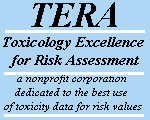|
|
Independent Peer Review
|
|
What: Independent Peer Review for the RfD on
Resorcinol An
independent panel of expert scientists met in This
review meeting followed a standard TERA
process, beginning with a close examination of the supporting
documentation and important references by the panel prior to the meeting.
At the meeting, the authors of the assessment briefly presented their
work. The panel then systematically discussed the assessment, starting
with a discussion of the qualitative weight of evidence, followed by a
discussion of the quantitative aspects of the assessment. The panel reached consensus that clearly enough data
exists on resorcinol to develop a RfD; however more of that data needs to
be included in the document in order to support the RfD and allow the
reader to independently evaluate its appropriateness. The panel reached unanimous consensus that sufficient
human data exists to reach the hazard identification conclusion that
resorcinol has the potential for thyroid effects in humans, but there are
insufficient data to draw conclusions regarding the dose response for
thyroid effects in humans. However
the panel also concluded that there was insufficient information presented
in the document to identify other potential target organs in humans. After an in-depth, point-by-point discussion of the
potential critical effects identified by the animal studies, the panel
unanimously concluded that the weight-of-evidence points to thyroid
effects as the critical effect for resorcinol.
There is a plausible mode of action, the data demonstrate a level
of consistency and there are good reasons for not seeing effects in the
animal studies that did not demonstrate thyroid effects.
Based on discussions regarding the animal studies, the panel
concluded that mortality, CNS effects, organ weight changes,
developmental/reproductive effects, and contact dermatitis were not
critical effects for the development of an oral RfD.
The panel noted that methemoglobinemia could potentially be a
critical effect, but there are no data to estimate a dose response. In conclusion, the panel reached unanimous consensus
that thyroid effects are to be considered the critical effect.
The Cooksey and Seffner studies are to be considered as co-critical
studies, supporting a point-of departure of 10 mg/kg-day.
Using the composite uncertainty factor of 100-300, as discussed
above, the resulting RfD for resorcinol proposed by the panel ranges from
0.03 to 0.1 mg/kg-day. The panel unanimously agreed that it should review a revised document, which incorporates the conclusions of the panel and provides additional narrative support in response to the panelís recommendations before the panel would approve this RfD for inclusion on ITER. |

